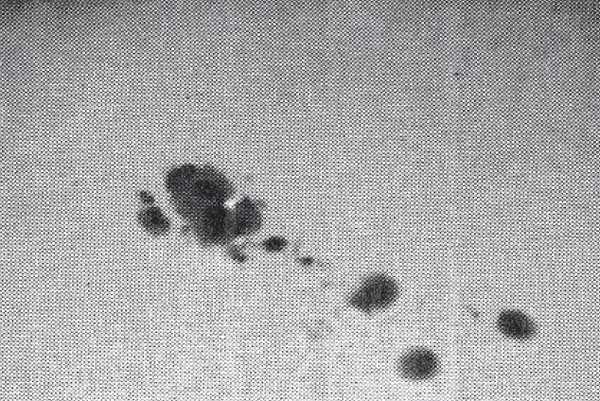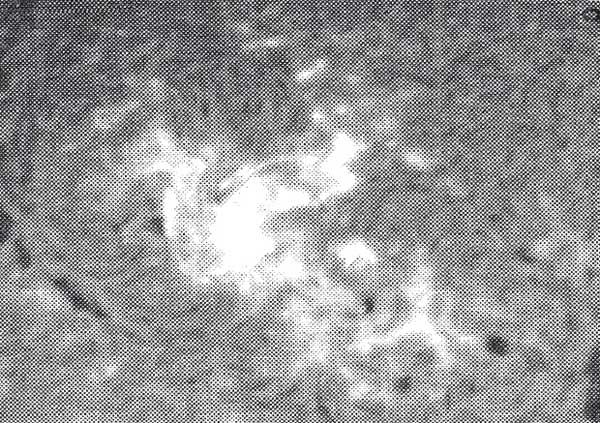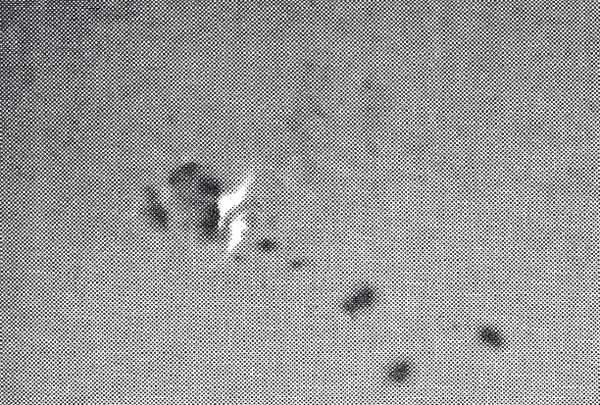1967 Solar Flare Nearly Took U.S. and Soviets to Brink of War
An historical study from former U.S. military officials found that a solar flare was nearly responsible for military conflict with the Soviet Union in May 1967.

A view of the Sun on May 23, 1967, at a narrow visible wavelength called hydrogen-alpha. The bright region in the top center region of brightness shows the area where the large flare occurred. (Click for larger version.)
National Solar Observatory historical archive
National Solar Observatory historical archive
On May 23, 1967, amidst the high-strung economic and political tension of the Cold War, all three of the United States' ballistic missile early-warning radars became simultaneously jammed. Located in the high-latitude areas of Alaska, Greenland, and the United Kingdom, these radars were designed to detect incoming Soviet missiles, and any attack or disruption of these radars were considered to be an act of war.
The United States Air Force, believing their radars had been intentionally jammed by the Soviet Union, authorized aircraft with nuclear-strike capabilities to take to the skies. Timely information from space-weather forecasters, who realized that it was a powerful solar flare jamming the radar, managed to prevent military action just in time.
A Powerful Solar Flare

The large sunspot group seen in late May 1967 sometime before the powerful flare that jammed military radar. This image of the solar surface (and those following) was taken at a narrow band of wavelengths around the hydrogen-alpha spectral line.
National Solar Observatory
National Solar Observatory
Just a few days earlier, an unusually large group of sunspots - cooler surface regions on the Sun associated with stronger solar magnetic fields - had rotated into Earth's view. By May 23rd, multiple solar observatories from all around the world were watching the active Sun. Observers documented a large solar flare erupting from the solar surface at 18:40 UT (2:40 p.m. EDT): a burst of powerful radio waves and X-rays was headed straight for Earth.
Solar flares, often the consequence of large sunspot patterns, are brief blasts of intense, high-energy radiation emitted from the Sun's surface. When aimed toward the Earth, they can cause geomagnetic storms, which have the ability to disrupt radio communications, power transmissions, and the motions of satellites.
Another consequence of geomagnetic storms is beautiful auroras, charged particles in the ionosphere typically seen inside the Arctic and Antarctic Circles. In the geomagnetic storm of 1967, auroras were reported as far south as New Mexico.
Military Response
Unaware of the solar activity, outside agencies and officials at the highest levels of the U.S. government put nuclear fighter jets on high alert, even as the Air Force’s Air Weather Service (AWS) was notifying the North American Air Defense Command (NORAD) of the solar activity.
Stationed at NORAD on the day of the solar flare was now-retired colonel Arnold L. Snyder, who recalls coordinating with a tropospheric weather forecaster also working at NORAD during the day of the event: "I specifically recall responding with excitement [to the atmospheric weather forecaster], 'Yes, half the sun has blown away!' and then related the event details in a calmer, more quantitative way."
AWS solar forecasters extracted enough information from solar observations taken at the Air Force Cambridge Research Laboratory to convince high-level decision makers at NORAD, and later the Strategic Air Command and the Pentagon, that the Sun was the culprit in contaminating the ballistic missile radar systems. The Air Force put U.S. fighters on a status of normal alert and nerves were calmed.
Acceleration of Space Weather Research

A third image taken at 18:44:00 UT on May 23rd shows the solar flare in progress.
National Solar Observatory
National Solar Observatory
Delores Knipp (University of Colorado, Boulder, and National Center for Atmospheric Research), lead author of the recent paper in Space Weather that's shedding light on the historical 1967 event, notes: "Had it not been for the fact that we had invested very early on in solar and geomagnetic storm observations and forecasting, the impact [of the storm] likely would have been much greater."
Indeed, the United States military began monitoring solar activity and what they loosely defined as "space weather" in the early 1950s. In the 1960s, a new branch of the Air Force's Air Weather Service began regularly monitoring the Sun for solar flares as well as coronal mass ejections - another potentially dangerous type of space weather event. By 1967, several observatories were sending daily information directly to NORAD solar forecasters, who predicted the significant worldwide geomagnetic storm.
While Knipp and colleagues write that the event was listed as one of the most significant events of the last 80 years, the solar storm of mid-1967 "has been of mostly fading academic interest." This new study shows that the event still has important implications for the future of research in areas such as space weather forecasting in a world dependent on radio, mobile phones, and satellite navigation.

No comments:
Post a Comment